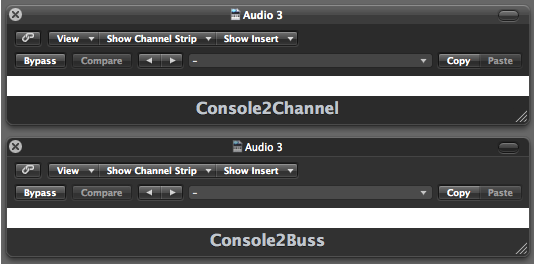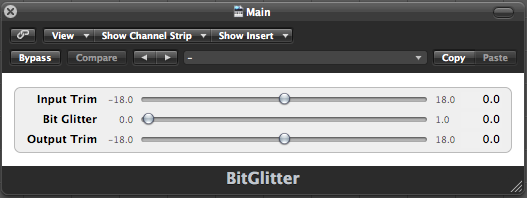Console2
Console2Demo is the very latest in DAW large format analog console emulation- without the ‘tone color’ part, which is already being handled by Desk and BussColors. Does the idea of a ‘very latest’ without tone coloring surprise you? Console2 surprised me. Here’s the backstory.
I’ve been working in this area for some time, and one thing people always ask for is analog crosstalk. Sometimes the conversations got extremely technical and heavy, with trained electrical engineers trying to convince me of the significance of varying buss input impedances, which wouldn’t be a huge deal in a well-designed console so far as I know…
Following one such thought experiment out, I figured out that if this was happening, a channel would distort easier if it was looking into a buss that was out of phase with it, because other channels would present negative impedances and pull some of the energy that would’ve gone to the output. In normal DAWs (and normal DAWs are working DAWs- doing crazy things to their software is a recipe for trouble) you can’t have the channels talking to each other like that, plus it could produce extraordinary CPU demands.
But what if there was a way to make a channel come across more distorted if it was feeding an out of phase buss, and less distorted if everything was in phase? The experiment was this: pre-distort all the channels in a calibrated way (like traditional tape noise reduction systems), sum everything, and then undistort it- apply negative distortion.
Negative distortion? Sounds crazy, but Airwindows has had it for years- take the original Density plugin, and set it to negative settings. Presto, un-saturation, inverse distortion. It sounds terrible—all by itself—but it does have a way of pushing stuff like ambience into the far distance.
When you pre-distort everything, and then apply the calibrated un-distortion on the buss (that would sound bad by itself), what happens is that everything in phase sums and gets expanded back again and sounds just the same. (actually, there’s a bit of peak compressing but it doesn’t sound bad—mostly it sounds just the same). Anything that is going more out of phase with the buss it actually doesn’t see, will end up not as far along the waveform as it thinks it is, and will get less of the un-distortion, so it’ll have more distortion left over, just as if it was able to consult neighboring tracks and apply its distortion relative to what the buss input impedance was.
Sonically, what you get is, the actual sounds don’t seem particularly altered, but the space between the sounds gets hammered with the full ‘undistort’ treatment, which if you remember, has a trick of sounding very distant and thin all by itself. But we’re not talking about the sounds anymore- they’re pre-compensated- we’re talking about the sound of the buss itself at this point.
That can best be summed up as ‘wildly 3D, huge, articulate, spacious’… frankly, it shocked the hell out of me the first time I heard it, not to mention when I started A/Bing it against raw DAW summing. The pure math DAW summing was ridiculously flat by comparison. Even Desk (my previous best solution) was ridiculously flat, though a much better texture. Turned out that nothing I’d previously done had addressed this problem at all, and suddenly I’d targeted it exactly.
You have to use the Console2 plugins in sequence, like they were analog noise reduction or something. Console2Channel goes at the end of all channels feeding the 2-buss, and Console2Buss goes first on the buss, before anything else- with ONE exception, you can use the default setting of BussColors3 in front of it (or Desk3, or a third party buss tone coloration plugin, if you like) because this type of processing won’t throw off the calibration (it’s too subtle) and it is improved by the expansion of space within it. But anything like compressors, tape effects, should only happen after Console2Buss, when the sounds are back to their intended forms. And if you are using BussColors3 to ‘slam the buss’ by turning up input gain, you should put it after Console2Buss, not before.
If you’d like this, buy the most recent Console and ask me for the older version in email. I’ll send it to you :)

